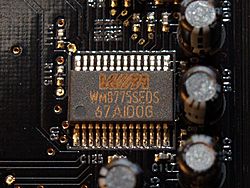Analog-to-digital converter facts for kids
An analog-to-digital converter (often called an ADC or A/D converter) is a special electronic device. Its main job is to change real-world signals, like sounds or light, into numbers that computers can understand. Think of it like a translator for electronics!
For example, when you speak into a microphone, your voice creates an analog signal. An ADC can take that wavy analog signal and turn it into a digital signal. This digital signal is then a series of numbers that a computer can store, process, or send.
ADCs are found in many electronic devices. They help turn things we can see, hear, or feel into information that digital devices can use.
Contents
Analog-to-Digital Converters
What is an Analog Signal?
An analog signal is like a continuous wave. It changes smoothly over time, just like the sound waves from your voice or the light coming from a lamp. These signals can have any value within a certain range.
Think of a dimmer switch for a light. You can turn it slowly, and the light gets brighter or dimmer very smoothly. That's like an analog signal. Other examples include:
- The temperature outside.
- The volume of music from an old radio.
- The pressure in a tire.
What is a Digital Signal?
A digital signal is very different. Instead of being smooth and continuous, it's made up of separate, distinct steps or numbers. Imagine a light switch that is either completely on or completely off – there's no in-between.
Computers and other digital devices work with numbers, usually zeros and ones. When an ADC converts an analog signal, it takes samples of the signal at regular times and turns each sample into a specific number. This series of numbers then represents the original analog signal.
How ADCs Work
The process of converting an analog signal to a digital one involves a few steps:
- Sampling: The ADC takes quick "snapshots" of the analog signal at regular intervals. Imagine taking many photos of a moving object.
- Quantization: Each snapshot's value is then rounded to the nearest available digital number. It's like measuring something with a ruler that only has whole numbers, so you round to the closest one.
- Encoding: Finally, these rounded numbers are turned into a digital code, usually a series of zeros and ones (binary code), which computers can understand.
The more snapshots an ADC takes (higher sampling rate) and the more precise its rounding (higher resolution), the more accurately the digital signal will represent the original analog signal.
Where are ADCs Used?
Analog-to-digital converters are super important in our modern world. They are in almost every digital device that interacts with the real world. Here are some places you'll find them:
- Digital Cameras: They turn the light coming into the camera lens into digital image files.
- Smartphones: When you record a video or make a call, ADCs convert your voice and the sounds around you into digital data.
- Computers: Sound cards in computers use ADCs to record audio from microphones.
- Medical Devices: Machines that monitor heartbeats or brain waves use ADCs to turn tiny electrical signals from your body into digital data for doctors to analyze.
- Music Players: While playing digital music, a digital-to-analog converter (DAC) is used, but ADCs are used when the music was first recorded.
- Sensors: Many sensors, like those measuring temperature, pressure, or motion, produce analog signals that need an ADC to be read by a digital system.
Images for kids
-
Comparison of quantizing a sinusoid to 64 levels (6 bits) and 256 levels (8 bits). The additive noise created by 6-bit quantization is 12 dB greater than the noise created by 8-bit quantization. When the spectral distribution is flat, as in this example, the 12 dB difference manifests as a measurable difference in the noise floors.
See also
 In Spanish: Conversión analógica-digital para niños
In Spanish: Conversión analógica-digital para niños








